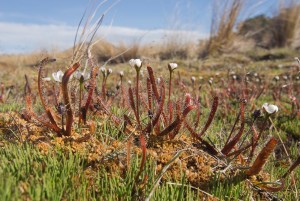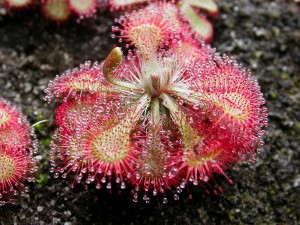Living organisms need to have consistent and reliable methods for procuring food in order to survive any situation. A steady food supply ensures survival not only of an individual organism, but also its offspring, as a healthy individual is more likely to successfully reproduce. For most human beings, it’s easy –we can hunt for it in our local surroundings – as we are equipped with the technology and resources to help us to do so in order to maintain our food supply. However, how does a living organism obtain food to ensure reproductive success within its local environment, when the environment itself may lack basic nutrients?
Plants that inhabit low-nutrient environments have adopted different strategies and abilities in order to live. For example, some plants possess the ability to ingest animals (as opposed to relying solely on sustenance derived from photosynthesis) to compose its diet. These plants, called carnivorous plants, use particular physical features, such as leaf color and spatial organization of its structures, to lure insects into their traps for food. While these distinct physical features offer may aid the plant in attracting its food supply, it can decrease its reproductive abilities, as potential pollinating insects may be trapped and killed for food. This trade-off is referred to as the pollinator-prey conflict (PPC). The PPC essentially is a delicate balancing of the immediate advantage of trapping insects for food supply and of the long-term danger in eliminating pollinators that are used for reproduction.

Drosera arcturi in New Zealand. http://www.newzealandphoto.info/photos/rosnatka-drosera-arcturi-fiordland-novy-zeland-301.jpg
In order to evaluate the role of physical features in the dynamics of the PPC, Jurgens and colleagues (2015) used sticky traps with various colors and structural alterations modeled after the carnivorous plants, Drosera arcturi and D. spatulata, in their natural environment in New Zealand. The researchers then compared capture rates of prey and pollinators in the artificial traps based on many variables, two of which were the color of the trap and trap-flower distance. They hypothesized that the color red deters pollinators from plants and that plants with longer distances between traps and flowers will prevent pollinator capture. Both of these physical features were believed to serve as visual signals to potential pollinators to avoid getting caught in Drosera‘s traps.

Drosera spatulata. http://upload.wikimedia.org/wikipedia/commons/c/c3/Drosera_spatulata_KansaiHabit.jpg
The results of their study revealed that the lowest trapping success for both pollinators and prey was attributed to red-colored model traps, as well as the conclusion that flower-trap distance did not impact pollinator or prey capture. Jurgens and colleagues’ (2015) results indicate that the effect of the color red specifically can protect pollinators from being captured. They suggest that the color effect may have evolved over time in order to ensure reproductive success in Drosera, demonstrating that living organisms apply different mechanisms in order to best promote their survival. Additionally, the researchers discovered that the trap-flower distance had an insignificant effect on pollinator capture, instead attributing pollinator attraction to a flower based on the visual cue of the flower structure itself. This suggests that currently, the dynamics of the PPC have not impacted the evolution of the overall trap-flower structure in Drosera.
Living organisms have evolved to best survive in low-nutrient environments by balancing this tricky trade-off between short-term and long-term advantages. Overall, these results indicate that the PPC can drive changes to the coloration of Drosera, demonstrating the powerful role that visual cues play in the survival of species.
Sources:
Jurgens, A., Witt, T., Sciligo, A., El-Sayed, A.M. (2015). The effect of trap colour and trap-flower distance on prey and pollinator capture in carnivorous Drosera species. Functional Ecology. doi: http://dx.doi.org/10.1111/1365-2435.12408
